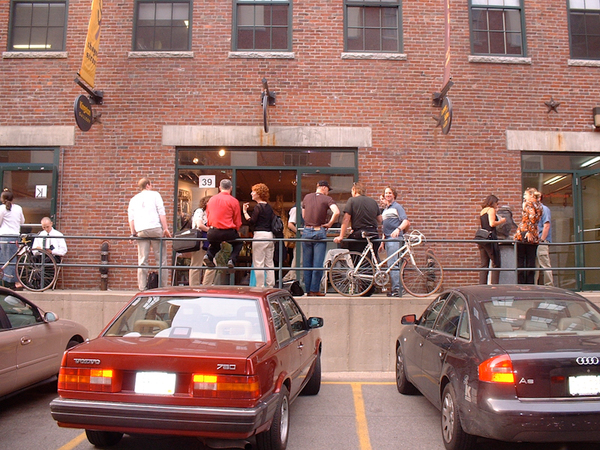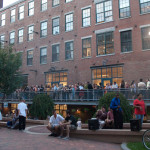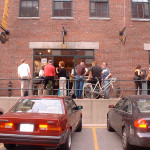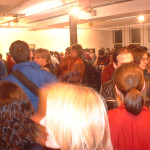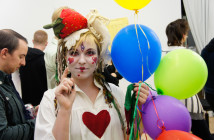If you owned a gallery, showed or performed your art, or if you just happened to go to an exhibit opening in the Boston / Cambridge area during the past six years then odds are pretty good that I have taken a photo of you that has ended up on “On The Town.” To all the hundreds of people I have photographed over the years for Big RED & Shiny, THANK YOU! and I apologize for all the awkward pictures I may have posted of you.
Soon after Big RED launched its first issue it became apparent the site needed a lot more photography to fill its pages. Matt Nash asked me to document what I was already going out to see and to post the results of my adventures here. It wasn’t long before I became quite obsessed and could not go to a show without my camera. Like the rest of the contributors and content on this site, there were no assignments, no one told me what to cover or where to go. I simply did what I have always done, I paid attention, did my homework, found out what was happening and went to take photos. I never got paid for the countless hours I have spent shooting and editing, I have paid out of my own pocket for the numerous still and video cameras and Terabytes of hard drive space I have have used to document and archive all the events that I have posted to this site. I have contributed to Big RED & Shiny because it is what I am passionate about and because it is my way of sharing with the rest of the world what I see happening out there.
While I have schmoozed at museum openings and snapped photos of curators and directors, traveled to art fairs and visited 99.9% of the galleries in the Boston/Cambridge area, I have always preferred covering exhibits and events off the beaten path. Garages, basements, parking lots, cafes, empty office spaces, if someone is having a show at an unusual place, I have always made an effort to be there and I will continue to do so as long as I am able. One of the things that excites me the most about “On The Town”, as with much of the rest of the content of Big RED, is that there are so much from the Boston art world on this site that is not documented anywhere else. I encourage all of you to dig through the archives and rediscover some of the amazing art, artists and events that have made Boston what it is!
If one takes the time to look it will become quite obvious that despite what some idiots posting to the forums here may think, the Boston art scene is not dead! It is evolving rapidly. The MFA and Gardner museum are moments away from epic expansions. The ICA is thriving and many of the long standing commercial galleries in Boston have gathered in SoWa. The alternative scene is also alive and quite well thanks to the success of AXIOM, MEME, The Fourth Wall Project, Rifrákt, and many other groups of dedicated artists and curators in the Boston/Cambridge area. So stop complaining unplug yourself from your Twitter page and go see what is happening out in the real world!
In my fifteen years in the Boston art scene, I have seen the rise and fall of more alternative spaces than I can count. In the late 1990s there was a boom in the alternative art scene driven by extremely affordable rents and a complete lack of venues willing to show art by emerging artists. Entire warehouse buildings in Fort Point, lofts in Chinatown, a subway station in Jamaica Plain, storefronts and offices, old bakeries and distilleries were transformed with drywall and track-lights and run by groups of idealistic artists and curators looking to make their mark on the scene. Labeled with colorful names like INSEKT, Oni, Berwick, Little White Box, The Revolving Museum, Nom D'Artiste, Maverick Arts, Crosstown Arts, Mobius, Studio Soto, Bad Girrrls, and White Elephant, to name but a few, some of these spaces lasted years, most were gone after a few shows, while others are still with us in one form or another. I was in the middle of the scene as the director/curator of two alternative gallery spaces during that time; ArtVigor which was located in a basement studio in East Boston and Gallery fx, a space dedicated exclusively to students and one of the first galleries in what is now known as SoWa. Like my efforts, nearly all of these alternative spaces were self–built and funded by our day jobs, maxed out credit cards, and endless nights with little or no sleep. The donation can, rare grants and even more rare sale of artwork helped to cover basic costs. Building code issues, rising rents, fights with landlords and other tenants, bad leases, fires, floods, mental breakdowns, breakups, as well as the occasional intervention by the authorities led to the fall of many of these spaces and eventually the collapse of the alternative arts scene which is just now starting to emerge again.
Spaces come and go and everything evolves with the use of technology, gone are the days of galleries built out in huge abandoned warehouses and wide open loft spaces, replaced now with smaller more intimate spaces in empty apartments, re-appropriated garages and temporary storefront locations. Websites and mass emails have replaced postcards and stamps. Late night postings to Facebook has replaced midnight runs of wheat-pasting Xeroxed flyers on city streets as the tool to get the word out. The the forums we gather and share our ideas in have also evolved.
Oni Gallery was at one time the central hub of the Boston art community, it was the place to see and the place to be seen, where we all gathered there to meet and share ideas. Oni has long since closed, but in many ways its spirit has lived on through Big RED & Shiny, thanks to the tireless efforts and endless dedication of Matt Nash and everyone else who has contributed here. For six years Big RED & Shiny has been the hub of our community and has been fueled by the same passion and dedication that drove all of us who have worked to make a difference in the Boston art world. With Big RED ending its run I have no doubt a new forum will emerge gaining from all the experiences contained on this site. Without question the art scene in Boston has evolved and will continue to evolve in the coming months and years. Perhaps someone reading this may be the one to take the initiative.
However the goals are the same. The need for the community, the stories and ideas exchanged are still there, it simply takes place on a different scale now. What is important are the artists, curators and individuals who make these things happen, not the square footage or how extravagant the build-out is. In many ways the need for a permanent space is far less important now. What is needed is the sense of community and the direct interaction between artist and audience. What matters is that there are some driven individuals out there who take it upon themselves to make it happen with whatever resources or space they have at the moment to give others the opportunities to better themselves in the art world.
THANKS!!!
- The same location as the above photo during First Friday openings September 2009.
- On the Town: Thayer St (Now known as SoWa) during an opening at Gallery fx in 2000
- On the Town: at Oni Gallery during a 2001 exhibit opening at its Washington street location.
Images from the author's extensive collection of photos of Boston art culture.

